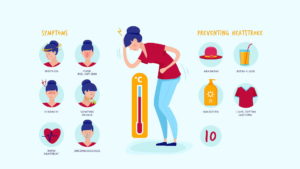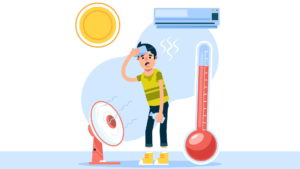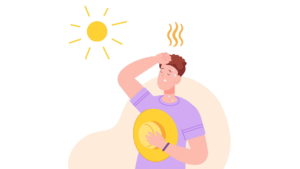Heat-related illnesses are the wide range of conditions brought on by extended exposure to high temperatures. These illnesses can vary in severity depending on the influence the sufferer is getting.
To Stay Safe is important in all terms, not just specifically. High temperature and even low temperature have the precautions a person must follow.
It is vital to be aware of the possible health hazards linked to higher temperatures. Staying safe in hot weather requires knowledge of the signs, causes, and appropriate treatment for many conditions. If you did not know, how would you keep yourself cool, comfortable, and healthy throughout the hottest months of the year?
If you do not know various heat-related illnesses, their symptoms, and the best ways to avoid them, there is no way you can avoid them.
Another important thing is to understand the factors or reasons of heat-related conditions.
The odds and intensity of heat-related disorders can both be increased by higher temperatures and high humidity. Elevated humidity holds back the ability of the body to cool down by making it harder for moisture to evaporate.
Furthermore, if an individual has a long length of time they spend in high temperatures, the danger of heat exhaustion or heatstroke increases, particularly in the absence of proper fluids or rest.
Heat-related illnesses can develop more quickly and become more severe if strong physical exercise is undertaken in hot weather. Running, playing sports, or performing energetic physical work are examples of activities that can quickly elevate body temperature, particularly if adequate fluids are not being taken to replace those lost through perspiration.
If we talk about Individual Factors, Older persons, small children, those with chronic illnesses, and people using medications that interfere with the body’s capacity to regulate temperature may all be more susceptible to heat-related disorders.
Moreover, by trapping heat and delaying the body’s ability to cool down, unsuitable clothing such as those with heavy or dark shades can raise the risk of heat-related illnesses. Another factor that may raise the risk of not preventing heat-related illnesses is not having access to cooling facilities or shade.
Most importantly, not getting enough fluids in the body can cause dehydration, which increases the risk of heat-related illnesses and makes it more difficult for the body to regulate temperature. Additionally, the body can sweat which is necessary for cooling and it gets diminished by dehydration
Understanding different Heat-related illnesses

Here is what you should know about different heat-related conditions you might suffer;
Heat cramps
These are severe seizures or cramps in the muscles that happen during or after vigorous exertion and perspiration in hot weather. Sweating removes salt and electrolytes, which is what causes heat cramps.
Heat cramps usually affect the arms, legs, or belly.
For preventing such heat-related illnesses, rest in a cool place, increase the number of liquids consumed, or get medical help if you feel ill, and there is no improvement.
Heat exhaustion

Compared to heat cramps, heat fatigue is a more serious heat-related sickness. It usually happens to those who work in hot, humid environments or who engage in energetic activity when they lose a lot of bodily fluids through perspiration. If heat exhaustion is not addressed right away, it might result in heatstroke.
Heat fatigue, a dangerous illness that can lead to heatstroke, usually happens when the body’s core temperature reaches 38–39°C.
Heat exhaustion signs and indicators include:
- Profuse perspiration
- Pale skin
- Cramping in the muscles
- Deficiency
- Headache and dizziness
- Vomiting and nausea
- Losing consciousness
- Quick heartbeat
Providing heat fatigue first help involves Taking the individual to a cool place and placing them down, taking off extra clothes, such as socks and shoes, Using ice packs or crushed ice in a moist towel on their neck, or armpits, as well as constantly cooling them and applying a cool, damp sponge or cloth will all help cool the person down.
Heat stroke

The most serious type of Heat-related illnesses is heat stroke. It happens when the body’s ability to regulate its temperature fails, causing the body’s temperature to climb dangerously high.
Failure to receive emergency medical attention to Stay Safe might result in lasting impairment or even death from heart stroke. High body temperature (typically greater than 104°F), disorientation, nausea, fast breathing, and rapid heartbeat are among the symptoms.
When the body’s core temperature increases above 40°C, heatstroke develops. This restricts blood supply to internal organs, which damages a number of the body’s organs. In preventing heat-related illnesses, the body temperature needs to drop right away because of the medical emergency.
Heatstroke signs and indicators could include:
- Confusion or anxiety
- Unconsciousness
- Excessive perspiration or heated, dry skin
- Shaking or seizure of the muscles
- Breathing rapidly
- Quick heartbeat
- Extremely high body temperature
Providing heatstroke first help to Stay Safe is important. One can Shift the patient to a cool, shaded spot and lay them down while awaiting emergency medical attention. Make sure the person has company.
Taking off extra clothes, such as socks and shoes is also important for preventing heat-related illnesses.
If the person is conscious and able to swallow, give them a drink of cool water.
Urgent hospital transportation in an ambulance is the best option to Stay Safe.
Heat Rash

Commonly referred to as prickly heat, heat rash is an irritant of the skin brought on by moisture too much in hot, muggy conditions. It is characterized by little red pimples or blisters on the skin and can strike at any age.
Although it can afflict people of any age, newborns and young children are most commonly affected.
By drinking plenty of water, avoiding extended exposure to high temperatures, dressing in light-colored, airy clothing, and taking pauses in the shade or air conditioning when feasible to stay safe, these symptoms of Heat-related illnesses can be avoided.
Sweating excessively, which clogs sweat ducts, might result in heat rash. The neck, upper chest, waist, groin, under the breasts, armpits, and skin folds are the areas where it is most likely to appear.
Heat rash symptoms include redness, slight swelling, and a collection of tiny red spots in the afflicted area. Itching and a prickling feeling are also frequently present. The duration of these symptoms may be many days.
Usually, the heat rash goes away on its own without any help. To Stay Safe avoid heat rash and facilitate its healing, you can:
To decelerate and minimize perspiration, relocate to a less humid, cooler, and well-ventilated space.
Keep the area that is impacted dry for preventing heat-related illnesses.
To reduce overheating, choose loose cotton clothing and stay away from scratchy materials that could irritate your skin.
It is advisable to seek additional medical assistance if symptoms do not improve.
Nonetheless, this is all about the Heat-related illnesses. Stay aware, stay safe, and stay protected.













